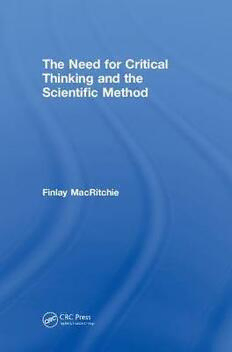
The Need for Critical Thinking and the Scientific Method PDF
Preview The Need for Critical Thinking and the Scientific Method
The Need for Critical Thinking and the fi Scienti c Method http://taylorandfrancis.com The Need for Critical Thinking and the fi Scienti c Method Finlay MacRitchie CRCPress Taylor&FrancisGroup 6000BrokenSoundParkwayNW,Suite300 BocaRaton,FL33487-2742 ©2018byTaylor&FrancisGroup,LLC CRCPressisanimprintofTaylor&FrancisGroup,anInformabusiness NoclaimtooriginalU.S.Governmentworks Printedonacid-freepaper InternationalStandardBookNumber-13:978-0-8153-6775-8(Paperback) InternationalStandardBookNumber-13:978-0-8153-6815-1(Hardback) Thisbookcontainsinformationobtainedfromauthenticandhighlyregardedsources.Reasonableefforts havebeenmadetopublishreliabledataandinformation,buttheauthorandpublishercannotassume responsibilityforthevalidityofallmaterialsortheconsequencesoftheiruse.Theauthorsandpublishers haveattemptedtotracethecopyrightholdersofallmaterialreproducedinthispublicationandapologize tocopyrightholdersifpermissiontopublishinthisformhasnotbeenobtained.Ifanycopyrightmaterial hasnotbeenacknowledged,pleasewriteandletusknowsowemayrectifyinanyfuturereprint. Except as permitted under U.S. Copyright Law, no part of this book may be reprinted, reproduced, transmitted, or utilized in any form by any electronic, mechanical, or other means, now known or hereafterinvented,includingphotocopying,microfilming,andrecording,orinanyinformationstorageor retrievalsystem,withoutwrittenpermissionfromthepublishers. Forpermissiontophotocopyorusematerialelectronicallyfromthiswork,pleaseaccesswww.copyright.com (http://www.copyright.com/) or contact the Copyright Clearance Center, Inc. (CCC), 222 Rosewood Drive,Danvers,MA01923,978-750-8400.CCCisanot-for-profitorganizationthatprovideslicensesand registrationforavarietyofusers.Fororganizationsthathavebeengrantedaphotocopylicensebythe CCC,aseparatesystemofpaymenthasbeenarranged. TrademarkNotice:Productorcorporatenamesmaybetrademarksorregisteredtrademarks,andare usedonlyforidentificationandexplanationwithoutintenttoinfringe. LibraryofCongressCataloging-in-PublicationData Names:MacRitchie,Finlay,author. Title:Criticalthinkingandthescientificmethod/FinlayMacRitchie. Description:BocaRaton:Taylor&Francis,2018.|Includesbibliographical references. Identifiers:LCCN2017059910|ISBN9780815367758(pbk.:acid-freepaper)| ISBN9780815368151(hardback:acid-freepaper) Subjects:LCSH:Science--Methodology.|Science--Socialaspects.| Criticalthinking. Classification:LCCQ175.M2352018|DDC001.4/2--dc23 LCrecordavailableathttps://lccn.loc.gov/2017059910 VisittheTaylor&FrancisWebsiteat http://www.taylorandfrancis.com andtheCRCPressWebsiteat http://www.crcpress.com Contents Preface.................................................................................................................xi About the author..............................................................................................xv Chapter 1 Introduction...................................................................................1 Part 1:Common misunderstandings ofthe scientific method.....................1 The topic ofdebate mustbe defined unambiguously..............................1 Atrue scientist mustbe detached...............................................................2 Ascientific theory can never be proven beyond doubt...........................2 Separate observations that are consistent withatheory do notcorrespond toadditional confirmation..........................................3 Refutability as acriterion for evaluating ascientific theory....................3 Consensus is nota criterion forthe validity of atheory.........................4 The illusion ofmodeling...............................................................................4 Part 2:General introduction..............................................................................4 The range ofcapacity forcritical thinking.................................................5 Distinction between science andpseudoscience.......................................6 Transition fromdogmatic tocritical thinking...........................................7 Howthis relates toanthropogenic global warming.................................8 Faults inapplication ofthe scientific method............................................8 Absence ofscientific thinking inpolitical debate......................................9 Summarizing thoughts.....................................................................................10 Chapter 2 Thescientific method................................................................13 The problem of demarcation...........................................................................14 Notable theories of theearly twentieth century..........................................14 Comparisons ofthe different theories...........................................................15 Guidelines forevaluating theories.................................................................16 Refutability as the criterion for demarcation................................................16 Probability and informative content..............................................................17 Conjectures and refutations............................................................................18 Criteria forevaluating atheory......................................................................18 The need forscience to grow(or toprogress)..............................................18 v vi Contents Requirements forprogress ofscience............................................................19 Dangers toprogress..........................................................................................19 References..........................................................................................................20 Chapter 3 Howthe lack ofscientific inputimpacts researchorganizations...............................................................21 Australian ministers incharge ofscience portfolio.....................................21 The contribution ofthe Honorable R.G. Casey............................................22 A short history ofCSIRO after its formation...............................................23 Changes resulting from reviews of CSIRO...................................................23 Howscientific knowledge is acquired...........................................................24 Howmanagerial controlpurports todrive science.....................................25 Comparison of thetwo approaches...............................................................26 Howhas the CSIRO fared?.............................................................................27 The requirement to obtainaproportion ofthe research funding.............27 Effect ofthese changes on theworkplace environment..............................28 The climate change controversy.....................................................................29 The lackof scientific thinking in thedebate.................................................29 Errors in application of science.......................................................................29 Balanced debate can still occur.......................................................................30 Expansion ofthe managerial approach.........................................................30 The present workingenvironment.................................................................31 The Victims ofCSIRO blog site......................................................................31 References..........................................................................................................32 Chapter 4 Howcould thishave happened?............................................33 A careerin science............................................................................................33 Effect ofthe requirement to procure funding...............................................34 Why do notmore scientists enter politics?...................................................34 Arescientists different?....................................................................................35 Howscience of excellence canstill be achieved..........................................36 Howcould it have happened?........................................................................37 Making decisions without thebasic knowledge..........................................37 Howimportant scientific discoveries are made...........................................38 Effect oforganizational changeson research................................................38 Where angels fear totread..............................................................................39 Where wasthe scientific leadership?.............................................................39 Why do toxic work environments form in scienceorganizations?...........40 Howdo toxic workplace environments arise?.............................................40 The control freak...............................................................................................41 The narcissist.....................................................................................................41 The serial bully..................................................................................................42 The psychopath.................................................................................................42 Whatis a psychopath?.....................................................................................43 Contents vii Characteristics of psychopaths.......................................................................43 Howare psychopaths identified?...................................................................44 The Hare checklist............................................................................................44 An example ofpsychopathic behavior..........................................................45 The legalargument...........................................................................................46 Psychopaths inscience.....................................................................................46 Whatis the origin of psychopathic behavior?..............................................47 Corporate psychopaths....................................................................................47 Howdo psychopaths attain high positions in corporations?....................48 Coping with psychopathic behavior..............................................................48 Howit happened..............................................................................................49 Notes...................................................................................................................50 References..........................................................................................................50 Chapter 5 Howthe media influences publicthinking..........................53 The myth ofthe lemmings..............................................................................53 The invasion ofIraqin 2003............................................................................54 The Chilean military coup of1973.................................................................55 Howcan wedecide what is thetruth?.........................................................56 Contrast between submissions to scientific journals and tothe mainstreampress...........................................................................57 Issues that seem tobe ignored by themainstream media.........................58 Agenda 21orsustainable development........................................................58 British immigration since early1980s............................................................59 The opinion writers..........................................................................................60 Howa democratic system canbreak down.................................................62 The rise ofsocial media...................................................................................63 Howto think foryourself................................................................................63 References..........................................................................................................64 Chapter 6 Dangerstoprogress in science................................................65 Dangers toprogress of sciencesuggested byPopper.................................65 Obsession with number ofpublications........................................................66 Quantity and quality in scientific publications............................................67 Citations and impact factors formeasuring merit.......................................68 Lackof citations topublications.....................................................................69 An excess of poor-quality research................................................................69 Negative flow-on effects from mediocre research.......................................70 Notmore scientists but more good scientists...............................................71 Effects ofexternal and internal forces............................................................72 Misconduct in science......................................................................................72 Moresubtle forms of unethical behavior......................................................73 Cases...................................................................................................................73 Conclusions from these cases..........................................................................74 viii Contents Fraud inscience may be moreprevalent than thought..............................74 Misallocation ofcredit......................................................................................75 Maintaining theintegrity ofscience...............................................................75 Authoritarianism...............................................................................................75 The earth as thecenter ofthe universe.........................................................76 Lysenkoism........................................................................................................76 Managerialism...................................................................................................77 References..........................................................................................................78 Chapter 7 Applying scientific thinking tosome current controversies...............................................................................79 Climate change..................................................................................................79 Observations consistent with previous onescannot be claimed asconfirmations................................................................................................80 The weakness ofmodeling..............................................................................80 The medieval warmperiod.............................................................................81 The Great Barrier Reef.....................................................................................82 Effects ofacidification of theocean................................................................83 The chemistry ofcarbon dioxide dissolution...............................................84 A critical examination is needed of thearguments for andagainst.........84 The saturated fat controversy.........................................................................85 Brief summaryofthe research on theeffects of saturated fats..................85 Problems forfood processors..........................................................................86 The problem of transfats................................................................................86 Replacement oftrans fats................................................................................87 The role ofcholesterol......................................................................................87 LDL and HDLcholesterol...............................................................................87 A critical examination of thesaturated fat–heart disease hypothesis......88 Epidemiological research versus clinical studies.........................................88 Selection bias.....................................................................................................88 Encroachment ofbureaucracy........................................................................89 Status ofthe hypothesis...................................................................................89 The advent ofgluten-free foods.....................................................................90 Celiac disease andgluten intolerance............................................................90 The need forgluten-free foods........................................................................90 Explosion ofgluten-free foods........................................................................91 The downside ofgluten-free diets..................................................................91 Genetic engineering..........................................................................................92 The possibilities forgenetic manipulation....................................................92 Gene drives........................................................................................................93 CRISPR...............................................................................................................93 Weighing the risks............................................................................................93 Contents ix Whatare the risks?...........................................................................................94 A critical examination of thecontroversy.....................................................95 References..........................................................................................................95 Chapter 8 Implementing scientific thinking and critical analysis......97 Research scientists in federalparliament......................................................98 Howto introduce more scientific thinking.................................................100 Changes needed inthe education system...................................................100 The role ofwonder in childhood education...............................................101 Teaching withmagic......................................................................................102 Creativity..........................................................................................................103 Introducing critical analysis..........................................................................103 Some simple examples...................................................................................104 Deflection ofan issue.....................................................................................105 Putting labels on opponents..........................................................................106 The straw manargument..............................................................................106 Could have or might have............................................................................106 The prism of ideology....................................................................................107 The influence ofcultural background on thecapacity forscientific thinking......................................................................................107 References........................................................................................................107 Chapter 9 Bringing it together.................................................................109 Scientific/critical thinking..............................................................................109 The scientific/critical versus the dogmaticapproach................................110 The diminished roleof scientists..................................................................111 The effects onscientific excellence................................................................112 Howscientific organizations can be infiltrated by destroyers.................113 The pros and cons ofdemocracies...............................................................113 Howcan wedetermine ifaproposed newlaw is better than the lawit replaces?................................................................................114 It’s theelectorate, stupid!...............................................................................114 The media........................................................................................................116 Howpublic opinion canbe influenced by themedia...............................116 Opinion writers...............................................................................................117 Dangers tothe progress ofscience...............................................................117 The lackof imagination or realinterest......................................................118 Howmanagerialism erodes the standard ofscientific research..............118 Isscience progressing?...................................................................................118 If scienceis not advancing as itshould, what is the cause?....................119 Howscientific progress canbe eroded by authoritarianism...................120 Flawsin the application ofthinking to some current issues...................120
